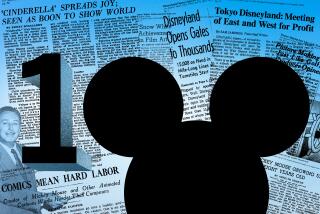Defending Disney’s ‘Hunchback’
- Share via
Patt Morrison’s attack on Disney’s “The Hunchback of Notre Dame” (“These Stories Are Classics for a Reason,” Calendar, June 21) demands a rebuttal--from a satisfied moviegoer who paid for his ticket, not a professional apologist for the studio or the industry.
Morrison tips her hand in the fifth paragraph, when having already condemned this “sappily-ever-after movie script” and “cinema sugar coating” (points for punning and alliteration, at least)--she breezily concedes, “I don’t know how the Disney version ends, but. . . .” Why not? Did she duck out mid-screening? Doze off? How valid can her critique be if she never finished watching it--or perhaps never even watched it at all?
If she had, she would have seen plenty of cruelty, ethnic persecution, religious hypocrisy, lust-maddened violence, a near-burning at the stake--and, yes, even defenestrations, crumbling skeletons and hangings (albeit the latter mainly as a comically macabre musical accompaniment). So Disney’s Quasimodo didn’t finally fling himself in despair on a pile of rotting corpses to join his beloved in death. What do you expect for a G rating, anyway?
Truth be told, having recently viewed the 1939 Charles Laughton “classic version”--which even Disney promotional literature describes as “the movie all the others want to be like”--it often suffers by comparison to Disney’s interpretation. Esmeralda (Maureen O’Hara) looks Caucasian, her fellow Gypsies look like Anglos in greasepaint, there’s far less exposition of the characters’ complex relationships, most of the darker elements are downplayed significantly and the ending is even more of a cheat. Gringoire rides off with Esmeralda to live happily ever after, while Quasimodo watches forlornly from a parapet with only a nearby gargoyle for companionship. In that light, Disney’s imaginary gargoyle sidekicks seem less of a heretical departure from Victor Hugo’s classic story than a lighthearted extrapolation.
Self-appointed cultural commissars have routinely disparaged Disney cartoons for decades, repeatedly wheeling out the same creaky complaint: They’ve Tampered With Art. Never, in this case, was an argument so misplaced. Disney detractors love the parlor game of defending the culture against the barbarians at the (studio) gate, but how many of them actually read, or have read, the classics they purport to protect? In this case, one might even question the intellectual bona fides of the published source material. Remember critic Andre Gide’s famous sneer, when asked to name France’s premier poet? His reply: “Hugo, alas.”
Besides, how many households today can boast “Notre Dame de Paris” on their bookshelves? Or Carlo Collodi’s “Pinocchio” or Lewis Carroll’s “Alice in Wonderland”? Or even fairy-tale collections containing the original Hans Christian Andersen “Little Mermaid,” the French folk tale “Beauty and the Beast” or any rendition of “Aladdin, or the Wonderful Lamp”?
The last time I checked, most of these were still in print and widely available in many Southland bookstores; they’ve not been displaced by the Disney versions. What’s stopping us from owning and reading them too?
As the parent of two youngsters--including a 4-year-old who snuggled in my lap, thoroughly entranced and delighted, throughout Disney’s “Hunchback”--I commend Disney for the audacity to adapt such adult “classics” for an expanding, youthful audience. And I embrace the opportunity to begin introducing my children to the original texts as soon as they are old enough to read.
This latest movie treatment of “Hunchback”--following the 1923 Lon Chaney silent, the Laughton reading, the 1958 Anthony Quinn version (though usually overlooked, it remains more faithful to Hugo) and the 1982 Anthony Hopkins television production--confirms anew what it really means to be a classic.
It means a story whose essential elements remain so powerful and resonant that succeeding generations of artists find continuing inspiration in fresh attempts to revisit and reinvent its presentation to succeeding generations of audiences. And they should be allowed to do so without having to apologize or justify their attempts to anyone else.
So, asked to name the 20th century’s premier popular storyteller, the answer might be “Disney, alas.” But it remains Disney all the same.
More to Read
Only good movies
Get the Indie Focus newsletter, Mark Olsen's weekly guide to the world of cinema.
You may occasionally receive promotional content from the Los Angeles Times.









